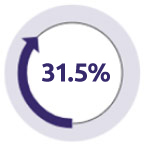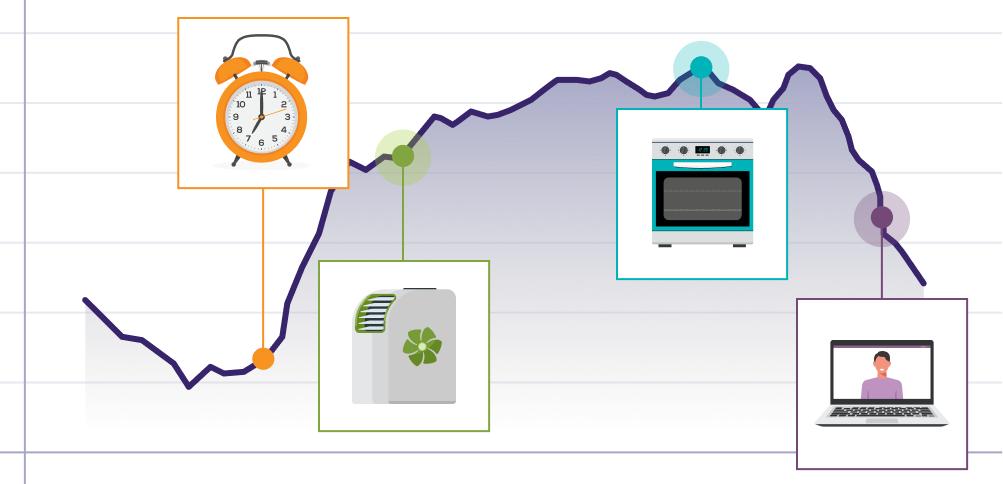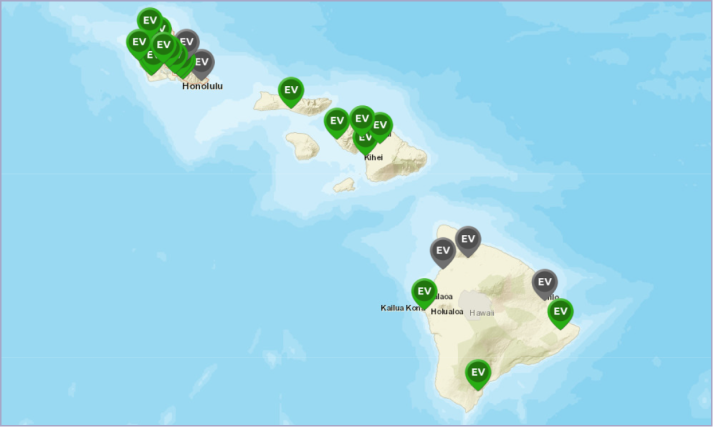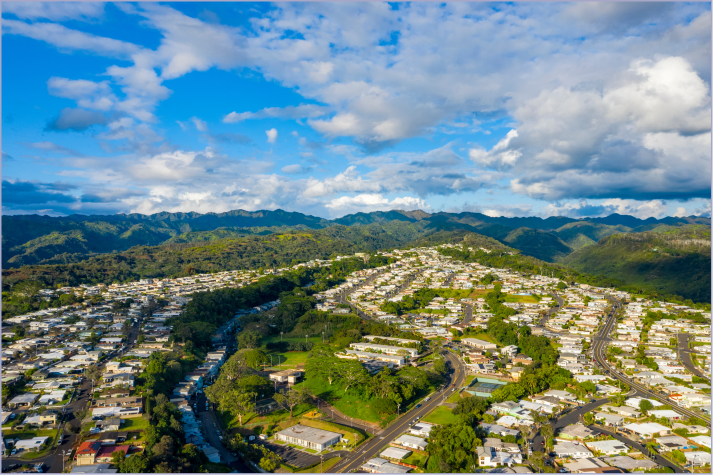Aloha!
Demystifying data
Hawaiian Electric is on track to power the electric grid with 100% renewable resources by 2045. To get there, it’s important to predict how much clean energy we’ll need to generate to meet future customer needs.
Forecasting the future of energy takes a lot of data. In this site, we’re breaking down the data and what it means for customers. We hope this site can help more people understand the inputs and assumptions that go into planning for a clean energy future.
Scroll on for the whole story, or jump to different sections using the buttons below. Mahalo for joining us!
1. Introduction
Decarbonizing the power grid Forecasting the future2. Analysis
Data dashboard3. A Closer Look
Energy efficiency Electrification of transportation Distributed energy resourcesDecarbonizing the power grid
Clean energy for Hawaii, by Hawaii
Before we dive into the data, let’s start with our clean energy goals. At Hawaiian Electric, our top priority is building a sustainable Hawaii in which our children and grandchildren, our communities, our customers and our employees will thrive, together. By 2045, we are committed to:
- Reaching net zero carbon emissions
- Meeting the state’s goal of using 100% renewable resources to power the electric grid
Good news: We are on track to meet these goals for a Hawaii Powered future! In 2021, 31.5% of our energy sales came from renewable resources. Transitioning to a clean energy grid supports a larger, collective effort to decarbonize Hawaii. Read the recent Sustainability Report to learn more.
Our goal for the future: 100% Renewables by 2045
2021 Recap: 31.5 Renewable Portfolio Standard (RPS) achieved
What is decarbonization?
Decarbonizing the power grid takes action on two pathways:
- How energy is consumed — efficiency, electrification of transportation, customer energy programs
- How energy is generated — renewables, alternative fuels, customer energy programs
Our clean energy planning involves walking down both these pathways at the same time. But in this website, we’re zooming in on just one of the pathways: how energy is consumed.
How do Customer Energy Programs fit into this framework?
Customer Energy Programs: Key to Decarbonization
You may have caught that customer programs are part of both pathways to a clean energy future. Customer programs can be about the way energy is consumed, like energy efficiency measures or charging electric vehicles. It can also be about the way energy is generated, like Shared Solar. Keep scrolling to learn more about customer energy programs.
Pathways to Decarbonization
- Efficiency
- Electrification
- Renewables
- Low-Carbon Fuels
How energy is consumed
How energy is generated
Forecasting the future
Predicting energy needs and costs
To decarbonize the power grid, we need to know:
- How much clean energy will we need to generate to meet customers' needs in the future?
- How will future demand and cost of resources affect customers’ bills?
Answering these questions is complex.
The short answer is: it depends!
Future energy needs and costs depend on...
You! Small, daily energy decisions add up to a big impact on the grid. Customer choices affect:
- Energy efficiency — How much energy will customers use overall? How many customers will use more efficient appliances and lighting?
- Electrification of transportation — How many customers will stop using gas-burning transportation and transition to electric vehicles? How quickly will this transition happen?
- Distributed energy resources — How many customers will participate in generating or storing their own electricty? Small-scale energy generation—together with larger, grid-scale generation— is key to supplying 100% renewable energy.
The cost of resources and available land for building new generation and transmission infrastructure also affect the future cost of energy.
Modeling inputs and assumptions
We plug in the factors or “inputs” listed above to model how much energy customers will need from the utility grid. This is an iterative and ongoing process—we will continue to update these scenarios as data evolves over time.
Here’s how the modeling process works:
- We use data to make informed assumptions about each input. Assumptions are about economic forces, customer choices and technologies. The data behind our assumptions comes from many sources...
- We combine inputs to map out low, medium and high scenarios for how much energy we’ll need to plan for, which we call “load” on the grid.
For our customers...
A higher load on the grid means more demand for electricity. More demand must be met with more supply, which generally comes from building more renewable generation and transmission infrastructure. More grid infrastructure:
- May cause greater impacts to communities and the environment.
- Comes with higher construction costs, which may increase customer bills.
- Will improve grid resilience to extreme weather events.
Explore the data dashboard to learn about the inputs, assumptions and scenarios we are currently using to forecast future energy needs. Then, take a closer look at each input.
Data dashboard Want a deeper dive into the data? Read the report that we submitted to the Public Utilities Commission.Data Dashboard
Future energy scenarios
Inputs based on different assumptions come together to create three scenarios for future energy needs. Select each of the three Scenario buttons to see how different inputs and forecast assumptions affect load. Then scroll down for a closer look at the assumptions for each input.
Dive deeper
- View data for each island using the dropdown
- Use the links below the graph to download all underlying data
- Hover over each ? icon to see definitions
- Moderate Scenario
- Low Scenario
- High Scenario
Inputs ?
Inputs are factors that affect the total amount of electricity demanded from the grid. Customer choices play a starring role in what these three inputs are like in the future.
Forecast Assumptions ?
Forecast assumptions are sets of conditions we assume about an input. These assumptions can be about economic forces, technologies or customer behavior. Scroll down to read more about assumptions for each input.
Load ?
Load is a measure of the total amount of electricity customers use. It’s measured in kilowatt-hours (kWh) — the same units you’d see on your Hawaiian Electric meter. Generally, higher load means we’ll need more generation and grid infrastructure.
Data downloads
IGP Documents Library Data reflects company’s filed inputs and assumptions from March 2022.What does low, moderate and high mean for each input?
The inputs below come together to form the load scenarios above. We’re making informed assumptions for how each input could look in the future. Learn about the assumptions we’re making to forecast different futures for each input.
-
Energy Efficiency

-
Electrification of Transportation

-
Distributed Energy Resources

Input Energy Efficiency
Energy efficiency is about reducing the overall amount of electricity we consume, especially at peak demand ? Peak demand is when customers are using the most electricity. Across Hawaii, peak demand is from 5 to 9 p.m. in the evening. Steep peaks can strain grid infrastructure and lead to higher utility bills. The good news is, customers can help reduce steep peaks and save money.. It also means improving buildings and appliances to become more energy efficient. Reducing our energy use and flattening peaks helps stabilize customer bills, reduce the risk of outages and decarbonize Hawaii.
Select the buttons below to see the different assumptions we’re making to forecast how efficient customers will be with their energy use through 2045.
The power to change is in our hands!
Customer Input Impact
By reducing your energy use, you can lower your electric bill and help Hawaii move away from fossil fuels and dependence on imported oil.See how this connects to customers
Hawaii's energy efficiency goal:
Reduce the state’s total electricity consumption by 4,300 gigawatt-hours by 2030. To put this in perspective: 1 gigawatt is enough to power about 750,000 homes!
Why do we need grid-scale generation?
We’re often asked, “Can Hawaii get to a 100% clean energy future if everyone installs solar panels on their rooftops?” As much as we love rooftop solar, the short answer is no. We’ll need a mix of small-scale and grid-scale generation ? Grid-scale means large generation facilities and transmission infrastructure. This includes wind turbines and solar facilities, as well as electric substations, poles and wires. to get to a Hawaii Powered future. There are few reasons why.
- 1 Solar isn’t right for every rooftop. It’s unlikely that we could install solar on every roof in Hawaii—not all roofs have the right conditions to generate solar energy, and some customers will be unable or unwilling to install panels.
- 2 A diverse grid is resilient. Generating electricity from a mix of resources and scales benefits our overall energy resilience and customer bills. Diversifying our energy generation to include small- and grid-scale projects keeps us from depending on any one source for all our electricity. This helps us bounce back faster from disasters and shields us from fluctuating costs of resources. For customers, this means a lower risk of outages and more stable bills.
- 3 Even if it could work, it wouldn’t power the whole grid. Forecasts show that private generation alone would not supply enough electricty to meet future energy needs. To replace just one fossil fuel generator, we expect the island will need new wind and solar projects with a collective footprint 29 times the size of Aloha Stadium. Grid-scale renewables are essential to supply this much energy.
Next Steps
Identifying opportunities to generate clean energy
Our journey has come full circle! Near the beginning of this site, we mentioned that decarbonizing the power grid takes action on two pathways:
- How energy is consumed – efficiency, electrification of transportation, customer energy programs
- How energy is generated – renewables, alternative fuels, customer energy programs
Modeling inputs and assumptions helped us understand the first pathway: how customer choices will affect how much energy we’ll need from the grid in the future. In our current phase of planning, we’re focusing on that second pathway: generation.
This means identifying resources, technologies and locations to generate and transmit enough energy to meet those future needs. We’re developing grid-scale generation and programs for customers to participate in generating and storing their own electricity.
How can community members get involved?
The Hawaiian Electric team will use input from community members and technical experts to inform our recommendations to the Public Utilities Commission. In 2022, you'll see invitations to share your thoughts online and in person about:
- Locations for future energy projects
- How best to involve your community in new project identification and development
Sign up for our email list to stay updated on opportunities to get involved.



























